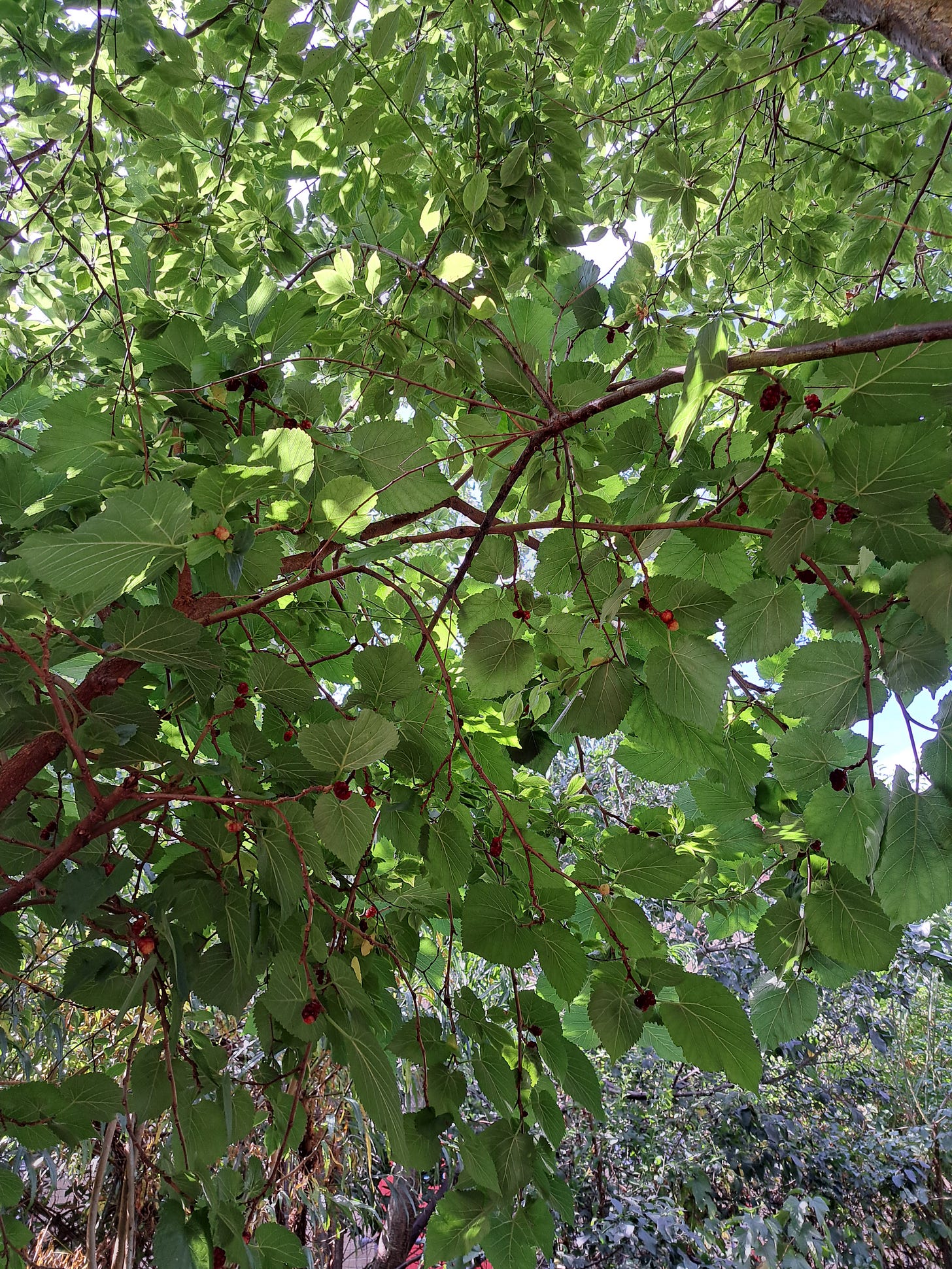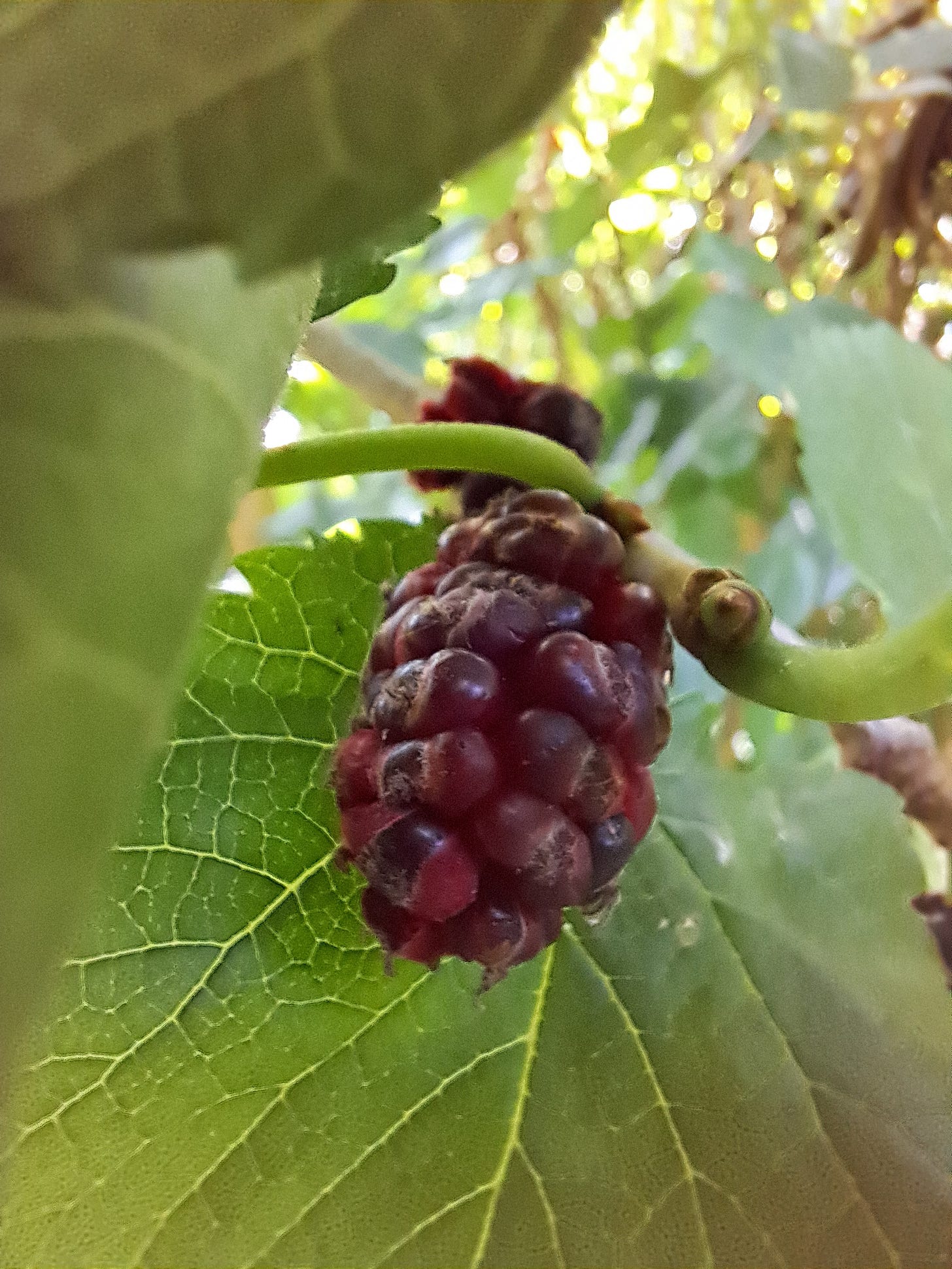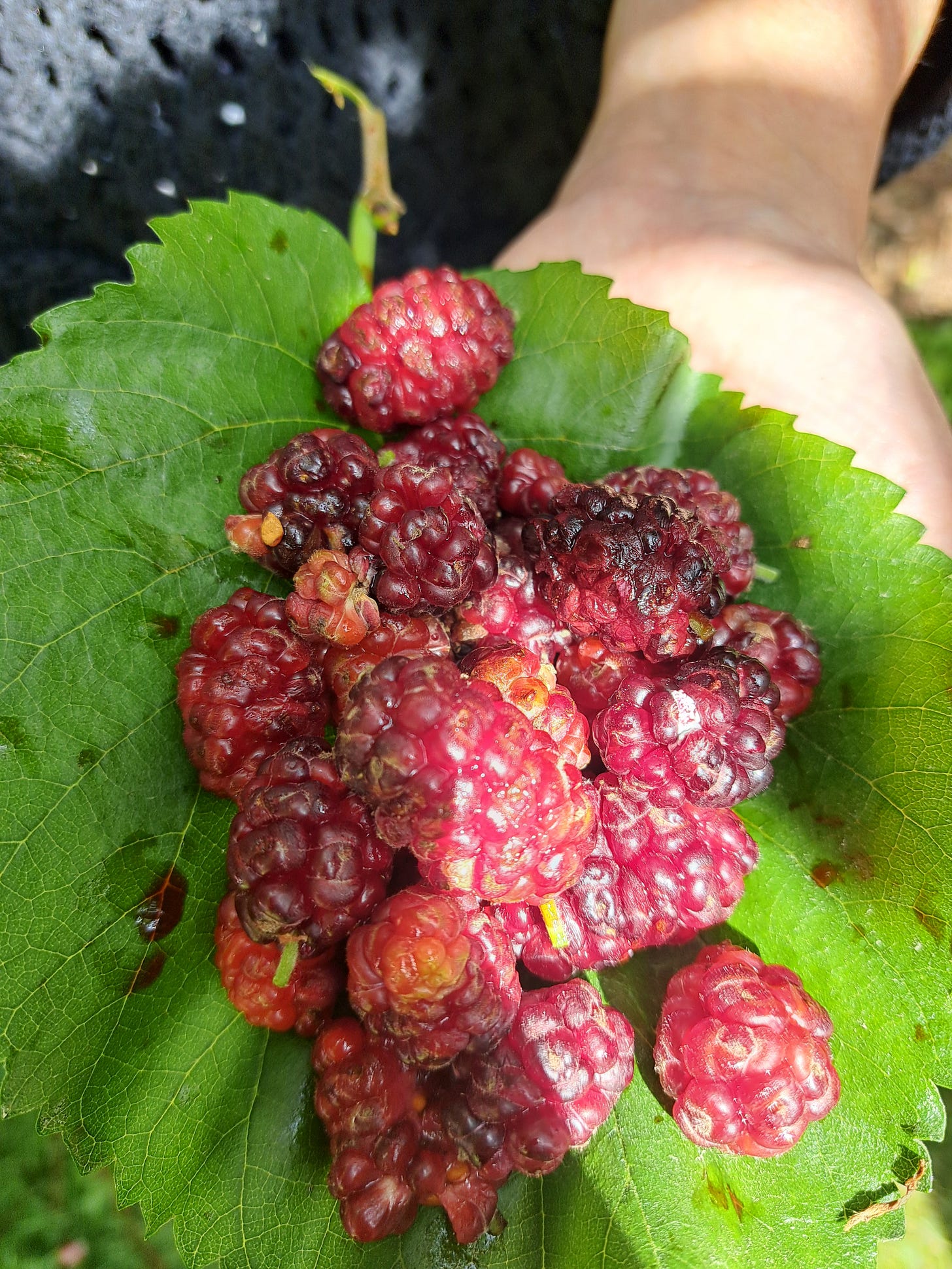Caught red handed
Mulberries. The joys of a complicated fruit. A mulberry poem. Mulberry granita.
A big welcome to my Substack newsletter. If you are already subscribed - thank you so much. It means the world to me! And if you are not yet a subscriber, hit the link below if you are interested in food markets, deep dives into food quirks and history, farmer stories and interviews.
Did you know that if you hit the HEART at the top or bottom of this post, it makes it easier for people to find this newsletter? (And also makes me very happy!)
How did I possibly manage before mulberries came into my life? Very occasionally, a farmer with their own mulberry tree would bring precious little boxes of the fruit to market. It was no coincidence that this farmer sold the best unpasteurised dairy. His rich double cream paired so beautifully with the little berries.
Searching them out, unless you have your own tree or orchard takes time and tenacity.
I’ve found them in a market in the Asian side of Istanbul, little wooden boxes of mulberries, waiting for recognition. We ate them as we walked through the narrow streets, wondering if anything else we found could be as good.
Mulberry trees are so ofton overlooked. Picking the fruit, people usually walk by without a curious glance. Last week with my family in Chichester, we discovered a venerable old mulberry tree in the Bishops’s Gardens. ‘Pick away’ the volunteer gardener said, so we did. A group of women asked what we were picking. When we told them, they were delighted. ‘Just like the nursery rhyme’ they said, declining the offer to taste the fruit.
Because people do not see it, they don’t think about it
Jane Grigson, writing about mulberries
There are white mulberries, morus alba, and there are black, morus nigra. The white mulberry is grown to feed silk worms as silkworms produce finer silk in greater quantity when fed on white mulberry leaves. The black mulberry for eating. Dried mulberries can be found in Iranian or Turkish shops. Often they’re white mulberries which I can only assume that once dried, the flavours become more concentrated.
Mulberries don't grow in little low lying clumps like strawberries. They're not bushes, despite the nursery rhythm, like blueberries or cloud berries, or thorny ramblers like blackberries or wine berries. They’re a tree fruit, and the trees can grow to great heights. You will rarely see them for sale, not just because they don’t travel well and defy you to pick them, leaving lasting purple stains on your hands and clothing. But also because the berries don’t ripen all at once. Get under the canopy of mulberry leaves if you’re lucky enough to find a tree, and spot the colours from pale cream to deep blood red. And the taste; crunchy, sharp and fruity like nothing else. The traditional way to pick mulberries was to spread a white sheet under the tree to catch the fruit before it hits the ground. I’ve got an inbuilt mulberry radar. If I spot a punnet of mulberries on social media, I want to know where they’re from, as with this post by food writer Ruby Tandoh
In Coriolanus, Shakespeare has Volumnia tell her son that he should be ‘‘humble as the ripest mulberry/That will not hold the handling’’.
For those of you in London, there is a mulberry map , sharing not only the tree locations but much about their heritage and history. The tree I pick from isn’t on the map and it’s not going to be. Those of us who have access to a mulberry tree, horde away the secret like buried treasure.
A few years ago I donated to a campaign to save the Bethnal Green mulberry tree. The oldest in Londons’ East End, it’s at the London chest hospital, then scheduled for redevelopment. 17,000 people signed the petition to save the tree and prevent it from being dug up and moved. The gift for helping out was either a cutting from William Shakespeare’s mulberry tree, or a pint of mulberry sorbet from La Grotta ices. The first cuttings didn’t take and died, and sadly, the same thing happened to the second. The next time they can try again is 2025, so I’m waiting for mine like mulberry tree owners awaiting their first fruits, very patiently. In 2040, the Bethnal Green Mulberry will reach its five hundredth birthday. I’m more than glad to have contributed to the appeal to save it.
The Mulberry is a venerable tree with many tales to tell. Of all the food stories that begin with the line; ‘imported by Romans’; the mulberry must be one of the earliest survivors. It’s been here for so long that no one can date its earliest arrival, but mulberry seeds found in excavations of Roman settlements near the Thames puts the cultivation of mulberries in London as early as the 1st century AD.
Does the phrase caught red handed come from picking mulberries? According to Tiptree Preserves it does. Tiptree own one of the only mulberry orchards in the country, with trees dating back to around 1860. Pickers come in August and the fruit is turned into a distinctive mulberry preserve.
An old black mulberry tree at the Inns of Court in central London has its own similar tale. Mulberry fruit was valuable and in the 16th century, if boys attempted to pick the fruit to sell, they were caught and punished because of the staining on their hands. Caught red handed.
How the mulberry got its dark red colour.
‘By that dark tide the berries on the tree assumed a deeper tint, for as the roots soaked up the blood the pendent mulberries were dyed a purple tint.’
The Roman poet Ovid wrote the tragedy of Pyramus and Thisbe in his Metamorphoses. Parodied by Shakespeare in A Midsummer Night’s Dream, he used the tale again for the deaths of Romeo and Juliet. Pyramus discovers the dead Thisbe by a white mulberry tree. In his grief, not wanting to live without her, he takes his own life. His blood stains the roots of the tree, turning the mulberries a deep red.
The black mulberry, grown for its fruit and shade is native to China, Iran and Turkey. White mulberries underpinned the silk industry in China and France.
According to Morus Londinium, in letters of 1607 and 1608 King James I of England asked the nobility to plant 10,000 mulberry trees to support an English silk industry to rival that of the continent. He also commanded the planting of thousands of white mulberry trees in Virginia. The trees thrived but a colonial silk industry didn’t emerge.
Lyon, once the capital of the French silk industry, houses a silk museum, the fascinating House of the Canuts. It tells the story of the evolution of Lyon silk from 1536 to the present day and step by step, see what happens to silk worms. Let’s just say that if you’re vegan you won’t be wearing silk.
Peter Coles, an authority on mulberries, calls it the tree of plenty for its role around the world, its medicinal properties, as a bringer of prosperity, and multitude of uses. Mulberry tree bark was used to make the first paper.
Tottenham cake, a sponge slab with bright pink icing was first made by Quakers using the fruit of a mulberry tree in Tottenham to colour the icing. I don’t know any bakery making it with mulberries, other than Quince Bakery in Islington, and it’s from Anna Higham, owner of Quince that the recipe for mulberry granita comes ( see below).

My mulberry poem
Black mulberry
you
soft seductive flirting taste of summer
morus lashes peak behind curtained leaves
bright dark eyes that defy anyone to steal you away
your fruits rare jewel ripe, red to glossiest black
like a cat lazing in the sun, you give
a come hither look, then
defy; be
quick to pick before your drupelets drop and dribble
you’d rather
splatter blood stained droplets onto the earth,
than be plucked
And if you do relent
fingertips are stained with retribution

If you’re lucky enough to find enough mulberries to cook with, may I recommend this simple recipe for a granita. Unlike a sorbet, with a granita you are encouraging ice crystals to form. It’s simple; use a timer to make sure that you’re forking up the mixture every couple of hours or so.
Mulberry granita
From The Last Bite by Anna Higham
Makes 400g
300g mulberries (I had about 250g. It was still fine.)
30g caster sugar
lemon juice to taste
mulberry eau de vie, to taste (optional)
Have ready ice cubes and a bowl for an ice bath….
Combine the mulberries, sugar and 100ml of water in a bowl set over a saucepan of barely simmering water. Cover the bowl and leave the mulberries to steep for 30 minutes or until they’re starting to burst and release their juices. Set the bowl in an ice bath to chill the cooked mulberries quickly.
Once they are cool, blend the fruit along with the juices. Pass through a fine sieve (I didn’t bother). Taste. If it needs a little boost, season with a scant squeeze of lemon juice. If you are lucky enough to come across mulberry eau de vie, this is the time to add a splash. Pour the mulberry puree into a shallow container and freeze.
Every couple of hours, scrape a fork through the freezing liquor so that you end up with large ice crystals rather than a fine snow. Once it’s completely frozen, scrape a fork through again to break it up further.










A mulberry love story! I had a mulberry tree in the garden of my first home here in Italy. I miss it every summer. I completely get why you guard your tree's location like a precious secret!
A lovely celebration of a wonderful fruit. 💜